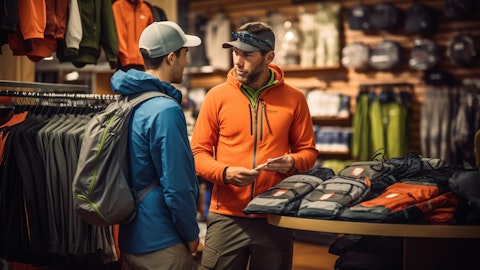So I think you’ll see that in wheeled cooler solution that we talked about on the call, and I think you’re going to see it in some other coolers later as we go into the year. So we feel great about the rounding out of the lineup on hard coolers. I think soft coolers really being back in full force with a full assortment and a full kind of addressing of the color range. I think it’s a great thing and then getting back and telling the consumers they’re back and ready to go. I mean that was a highlight product for us as we wrapped 2022. And obviously, 2023 we had the voluntary recall, but we’re ready to get back at it with the soft coolers. And I think you’ll see us a little louder out there about the soft coolers and really getting after the hard cooler new product launches this year.
Operator: The next question comes from Robbie Ohmes with Bank of America. Please go ahead.
Robert Ohmes: Oh, hey Matt. So I wanted to follow up on the M&A strategy since I think this is the first chance we’ve had to really hear you talk about it. So a couple of things. Can you — are you — when you’re making these acquisitions and maybe future acquisitions, is there a significant IP in Mystery Ranch or Butter Pat that’s applicable to the YETI line, is there like an IP story behind some of these acquisitions, and is that — what you’re looking at a lot in future acquisitions? And you guys have mentioned the play between Mystery Ranch and YETI as something — can you elaborate a little more on that like we should expect YETI to be a little softer, maybe in certain places because of the Mystery Ranch acquisition, I just wanted to get more clarification on that?
Matthew J. Reintjes: Thanks, Robbie. Yes, I would say whenever we — and we talked a little bit about this, but whenever we look at M&A through the lens of product, which is really what we’re doing here, we’re looking for talent acquisition in what I would call technology or designs and kind of technology and designs in conjunction for what they bring that we think is a differentiated point of view that’s leverageable and that’s scalable. So when I think about the Misery Ranch acquisition and when you think about the YETI product portfolio today in bags, we have high-end waterproof, fully submersible packs that have been a wonderful part of the YETI story. We’ve expanded into kind of higher end everyday packs. Mystery Ranch really brings two things that I think are important.
One, impacts. One is carry and the other one is access, how you use the product. And there are some things around the Mystery Ranch designs that are protectable and have been protected that we really like around the carry and around the access and design that we think has the potential to be really ownable, scalable, identifiable as you think about building out the packs brand. So it is something that as we look at acquisitions, technology, design, talent are really the three big things because we are thinking about this like additions to our product development engine. As it relates to the interplay between YETI legacy bags and the Mystery Ranch packs, I think what Mike was expressing is we just don’t know exactly how they’ll interplay and kind of — when you do this, you create awareness around the category.
And so as we bring those — that assortment together, there’s going to be some moving parts in there. There’s going to be some SKU rationalization, there’s going to be some price point rationalization, that’s going to be kind of building up that assortment. So I think we just went into the year with a little bit of being thoughtful about how we plan for it in year one. And then in year two, we expect to kind of build out a more robust portfolio.
Robert Ohmes: Got you. That’s really helpful. And then, Mike, I just want to clarify, on the 2024 guidance — just a couple of quick things, do you expect Amazon to be a growth driver, should it be balanced growth support from Amazon and YETI online in 2024, similar to 2023 or would you be leaning on one channel more than another? And then the other clarification, just the on the non-wheeled coolers and pricing and things like that, is there a need for inventory clearance in some of the legacy non-wheeled large ticket coolers and we might see you guys showing up with those, I know a long time ago, you guys had shown up in the off-price channel with some soft cooler bags with the zipper that wasn’t that great, but anything like that we should anticipate for 2024?
Matthew J. Reintjes: Hey Robbie, so thanks for the questions. First, on the DTC sub channels, we expect relatively balanced growth across our own e-commerce, Amazon, corporate sales, the three major ones. Amazon obviously had a really, really strong year in 2023, and that was a big part of the SG&A story in 2023. As we go into 2024, we expect those to be more balanced. As we think about your second question around inventory, I mean, just to be clear, what we talked about was, as we’re introducing new products, you’ve seen us do this before, we’ll change our pricing stack to just make sure that the entire portfolio makes sense as we look at price versus value. And so that’s really what’s happening here. There are — I would — just to directly answer the question, there’s really no inventory clearance risk as we look out to the year.
You’ve seen us from time to time, take things end of life as we introduce new innovation. But there — as we look out for the year, there’s — I wouldn’t call out any significant risk for — it is significant end of life risk with any different than what we’ve done in the past.
Operator: The next question comes from Jim Duffy with Stifel. Please go ahead.
James Duffy: Thank you. I wanted to ask about the hard cooler category. The question is what gives you the confidence that the pressures are related to the macro versus simply maturity of the category and perhaps saturation of the addressable market after a number of strong years of sales?
Matthew J. Reintjes: Hey Jim, this is Matt. Thanks for the question. I think that’s a question that we’ve been answering for years on how many more hard coolers can you sell and obviously, we’ve been selling hard coolers since 2006 and we’ve continued to drive growth in that. I think the thing that was most interesting, is why we were — tried to be very clear about that dynamic is we had nine months of very strong consumer demand in hard coolers and we saw a pretty acute change in the fourth quarter. And when we go back through our continued improving in what I think are pretty powerful consumer analytics and data analytics capabilities now, really we started to piece apart the dynamic that came to play in Q4. We look at the market opportunity, we look at consumers that own YETI cooler vis-a-vis consumers that know the YETI brand or own YETI drinkware, where we look at the global opportunity that remains untapped in hard coolers, the price points that we still haven’t filled in the mobility solutions, as we talked about with this wheeled cooler.
And we believe that hard coolers has a continued and a significant place for YETI going forward. So I think that challenge that consumer dynamic that we saw, I think the biggest thing for us was just how quickly that changed from nine months of really strong performance.
James Duffy: And then the packs category, it seems like a lot of exciting opportunity there, including luggage. Layne’s a great addition to the team, he knows the category well. Curious how you see leveraging Mystery Ranch, I think of them as being appreciated by hunters for carrying heavy loads. Do you see the opportunity in expanding that capability to the YETI line or is there opportunity leveraging Mystery Ranch into broader categories like those occupied by Osprey and others, perhaps with larger addressable audiences?
Matthew J. Reintjes: Yes, I would say — thanks, Jim, and it’s a great question, a great insight. Mystery Ranch is known for their carry systems. And what I mentioned earlier, and I believe Robbie’s question was carry and access are two hugely important things in driving differentiation in packs. And so we see with Layne’s leadership and the talent team we now have in Bozeman with the talent — incredibly talented team we have in Austin, the ability to really become not only a big player and a relevant player in outdoor broadly, but also everyday carry. And I think that’s where Mystery Ranch as a brand had made a little bit of move there, but their legacy history was really tied into those heavy hauling, heavy carry environments. And so that’s why we saw incredibly complementary and we think those technologies and those designs are leverageable and have more broad, more scalable application.
Operator: The next question comes from Noah Zatzkin with KeyBanc Capital Markets. Please go ahead.
Noah Zatzkin: Hi, thanks for taking my questions. With the comments around balanced channel growth this year, how should we think about the mix between DTC and wholesale looking longer-term, is the current mix kind of the right way to think about the business or would you expect to reaccelerate DTC relative to wholesale in 2025 and beyond? Thanks.
Matthew J. Reintjes: Hey Noah, thanks for the question. So correct. So we expect the two channels to grow relatively in line with each other this year, but there’s really one thing I’d call out in that, in year one of Mystery Ranch, we expect a higher mix of wholesale versus direct. So that’s one factor that is driving them to kind of grow more in line with each other. But over the long term, we believe that DTC will grow faster than wholesale. And not only just with our investments in DTC across both e-commerce and corporate sales, strategic partnerships, stores, etcetera but also as we look outside the U.S. We don’t have that full complement of DTC channels in the other regions where we’re operating, Europe, Canada, Australia. So as we look to build out those other DTC channels within those new regions, we think that’s going to help drive faster growth in DTC over the long term.
Noah Zatzkin: Thank you.
Operator: The next question comes from Megan Alexander with Morgan Stanley. Please go ahead.
Megan Alexander: Hi, thanks very much. I just wanted to maybe touch on the new price points in coolers. You’ve been pretty steadfast in wanting to maintain the premium positioning. So I guess how should we think about introducing some lower price points, your comments on marketing, and how you kind of balance that with the strategy to maintain a premium position?
Matthew J. Reintjes: Hi Megan, thanks for the question. What I would say is we do not plan to introduce a price point that is a new price point — entry price point for YETI being a place we’ve not been before. So this is not — I wouldn’t expect to see a significant step down from any sort of pricing. This will make a lot of sense from bottom to top. And so it’s a price point we’ve been at before.
Megan Alexander: Okay, that makes a lot of sense. And then maybe just a follow-up on maybe Mystery Ranch in particular. Can you give us any more color on maybe the margin profile of that business and what growth has maybe looked like for that business over the last year or two?
Michael J. McMullen: Hey Megan. So we didn’t disclose any specifics on the Mystery Ranch business other than to say that we believe the two acquisitions we will provide this year from a total growth standpoint. And then we said that they are slightly EPS accretive. But beyond that, I’d say from a margin profile, it doesn’t have a — obviously, we didn’t call it out as a significant driver this year. And so I would not expect a — we don’t expect a significant impact from that in 2024. But I mean, like Matt said, we think there’s significant opportunity to grow that business in the overall bags business. And both from a wholesale and a DTC standpoint and then also both inside the U.S. and international as well.


